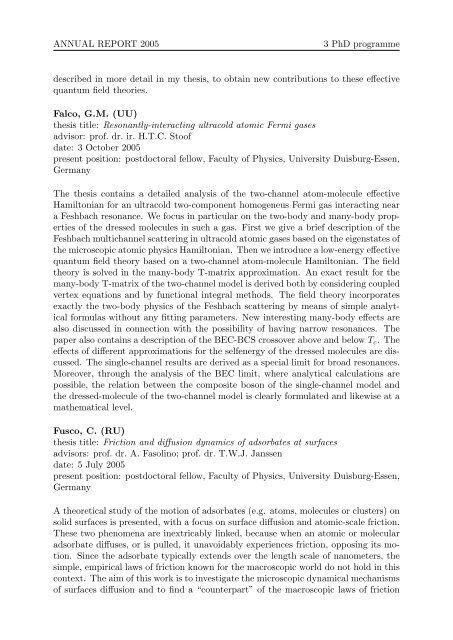ANNUAL REPORT 2005 - Universiteit Utrecht
ANNUAL REPORT 2005 - Universiteit Utrecht
ANNUAL REPORT 2005 - Universiteit Utrecht
Create successful ePaper yourself
Turn your PDF publications into a flip-book with our unique Google optimized e-Paper software.
<strong>ANNUAL</strong> <strong>REPORT</strong> <strong>2005</strong>3 PhD programmedescribed in more detail in my thesis, to obtain new contributions to these effectivequantum field theories.Falco, G.M. (UU)thesis title: Resonantly-interacting ultracold atomic Fermi gasesadvisor: prof. dr. ir. H.T.C. Stoofdate: 3 October <strong>2005</strong>present position: postdoctoral fellow, Faculty of Physics, University Duisburg-Essen,GermanyThe thesis contains a detailed analysis of the two-channel atom-molecule effectiveHamiltonian for an ultracold two-component homogeneus Fermi gas interacting neara Feshbach resonance. We focus in particular on the two-body and many-body propertiesof the dressed molecules in such a gas. First we give a brief description of theFeshbach multichannel scattering in ultracold atomic gases based on the eigenstates ofthe microscopic atomic physics Hamiltonian. Then we introduce a low-energy effectivequantum field theory based on a two-channel atom-molecule Hamiltonian. The fieldtheory is solved in the many-body T-matrix approximation. An exact result for themany-body T-matrix of the two-channel model is derived both by considering coupledvertex equations and by functional integral methods. The field theory incorporatesexactly the two-body physics of the Feshbach scattering by means of simple analyticalformulas without any fitting parameters. New interesting many-body effects arealso discussed in connection with the possibility of having narrow resonances. Thepaper also contains a description of the BEC-BCS crossover above and below T c . Theeffects of different approximations for the selfenergy of the dressed molecules are discussed.The single-channel results are derived as a special limit for broad resonances.Moreover, through the analysis of the BEC limit, where analytical calculations arepossible, the relation between the composite boson of the single-channel model andthe dressed-molecule of the two-channel model is clearly formulated and likewise at amathematical level.Fusco, C. (RU)thesis title: Friction and diffusion dynamics of adsorbates at surfacesadvisors: prof. dr. A. Fasolino; prof. dr. T.W.J. Janssendate: 5 July <strong>2005</strong>present position: postdoctoral fellow, Faculty of Physics, University Duisburg-Essen,GermanyA theoretical study of the motion of adsorbates (e.g. atoms, molecules or clusters) onsolid surfaces is presented, with a focus on surface diffusion and atomic-scale friction.These two phenomena are inextricably linked, because when an atomic or molecularadsorbate diffuses, or is pulled, it unavoidably experiences friction, opposing its motion.Since the adsorbate typically extends over the length scale of nanometers, thesimple, empirical laws of friction known for the macroscopic world do not hold in thiscontext. The aim of this work is to investigate the microscopic dynamical mechanismsof surfaces diffusion and to find a “counterpart” of the macroscopic laws of friction
















